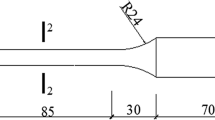Abstract
In this study, elastic waves generated from a SKD11 (HV670) steel specimen under various corrosive solutions were investigated. The frequency characteristics of the waves, as well as how hydrogen aggregation and crack propagation affected these characteristics, were studied using time-frequency analysis conducted in LabVIEW. The waves detected were either in a low frequency band, below 40 kHz, or in a high frequency band, above 60 kHz. The low frequency waves below 40 kHz were caused by hydrogen aggregation and corrosion, while the high frequency waves above 60 kHz were caused by crack initiation and propagation due to HAC. Inspection by SEM confirmed that the grains and cracks were caused by HAC via hydrogen embrittlement.
Similar content being viewed by others
References
M. R. Louthan Jr., G. R. Caskey Jr., J. A. Donovan and D. E. Rawl Jr., Hydrogen embrittlement of metals, Materials Science and Engineering, 10 (1972) 357–368.
J. Toribio and M. Elices, Influence of residual stresses on hydrogen embrittlement susceptibility of prestressing steels, International Journal of Solids and Structures, 28 (1991) 791–803.
W. Y. Chu, J. Yao and C. M. Hsiao, Hydrogen induced slow crack growth in stable austenitic stainless steels, Metallurgical Transactions A, 15 (1984) 729–733.
D. Figueroa and M. J. Robinson, Hydrogen transport and embrittlement in 300 M and AerMet100 ultra high strength steels, Corros. Sci., 52 (2010) 1593–1602.
L. W. Tsay, H. L. Lu and C. Chen, The effect of grain size and aging on hydrogen embrittlement of a maraging steel, Corros. Sci., 50 (2008) 2506–2511.
B. G. Pound, The effect of aging on hydrogen trapping in precipitation-hardened alloys, Corros. Sci., 42 (2000) 1941–1956.
D. Hardie, E. A. Charles and A. H. Lopez, Hydrogen embrittlement of high strength pipeline steels, Corros. Sci., 48 (2006) 4378–4385.
D. Figueroa and M. J. Robinson, The effects of sacrificial coatings on hydrogen embrittlement and re-embrittlement of ultrahigh strength steels, Corros. Sci., 50 (2008) 1066–1079.
L. W. Tsay, M. Y. Chi, Y. F. Wu, J. K. Wu and D. Y. Lin, Hydrogen embrittlement susceptibility and permeability of two ultra-high strength steels, Corros. Sci., 48 (2006) 1926–1938.
W. Y. Chu, T. H. Liu, C. M. Hsiao and S. Q. Li, Mechanism of stress corrosion cracking of low alloy steel in water, Corrosion, 37 (1981) 320–327.
L. W. Tsay, Y. F. Hu and C. Chen, Embrittlement of T-200 maraging steel in a hydrogen sulfide solution, Corros. Sci., 47 (2005) 965–976.
W. Y. Chu, L. J. Qiao, Y. B. Wang and Y. H. Cheng, Quantitative study for sulfide stress corrosion cracking of tubular steel, Corrosion, 55 (1999) 667–673.
H. L. Li, K. W. Gao, L. J. Qiao, Y. B. Wang and W. Y. Chu, Strength effect in stress corrosion cracking of high-strength steel in aqueous solution, Corrosion, 57 (2001) 295–299.
Y. P. Zhang, D. M. Shi, W. Y. Chu, L. J. Qiao, Y. L. Shi, S. L. Zheng and S. B. Wang, Hydrogen-assisted cracking of T-250 maraging steel, Mater. Sci. Eng. A, 471 (2007) 34–37.
D. D. Dedhia and W. E. Wood, Application of acoustic emission analysis to hydrogen-assisted cracking, Materials Science and Engineering, 49 (1981) 263–273.
A. K. Bhattacharya, N. Parida and P. C. Gope, Monitoring hydrogen embrittlement cracking using acoustic emission technique, Journal of Materials Science, 27 (1992) 1421–1427.
K. S. Lee, J. E. Paeng, K. H. Gu and K. W. Nam, Threshold stress intensity factor of ultra-high strength steel (HV670) containing surface crack by hydrogen assisted cracking and cumulative elastic wave, J. Mech. Sci. Technol., 35 (2021) 2441–2447.
M. Strantza, D. V. Hemelrijck, P. Guillaume and D. G. Aggelis, Acoustic emission monitoring of crack propagation in additively manufactured and conventional titanium components, Mechanics Research Communications, 84 (2017) 8–13.
M. Barski and A. Stawiarski, The crack detection and evaluation by elastic wave propagation in open hole structures for aerospace application, Aerospace Science and Technology, 81 (2018) 141–156.
M. Chai, C. Lai, W. Xu, Q. Duan, Z. Zhang and Y. Song, Characterization of fatigue crack growth based on acoustic emission multi-parameter analysis, Materials, 15 (2022) 6665.
Author information
Authors and Affiliations
Corresponding author
Additional information
Ki-Sik Lee is a graduate student at Pukyong National University, Busan, Korea. He is interested in strength improvement of structural material.
Jae-Eun Paeng is a graduate student of Marine Design Convergence Engineering at Pukyong National University, Busan, Korea. She is interested in the fatigue life and the corrosion behavior of structural material.
Ki-Woo Nam (Ph.D.) is working on Department of Materials Science and Engineering & Marine Design Convergence Engineering at Pukyong National University, Busan, Korea. His research fields are the crack healing and the harmless crack of structural component.
Rights and permissions
About this article
Cite this article
Lee, KS., Paeng, JE. & Nam, KW. Elastic wave properties in ultra-high strength steel (HV670) exposed to various corrosive solutions. J Mech Sci Technol 37, 1723–1729 (2023). https://doi.org/10.1007/s12206-023-0313-0
Received:
Revised:
Accepted:
Published:
Issue Date:
DOI: https://doi.org/10.1007/s12206-023-0313-0




